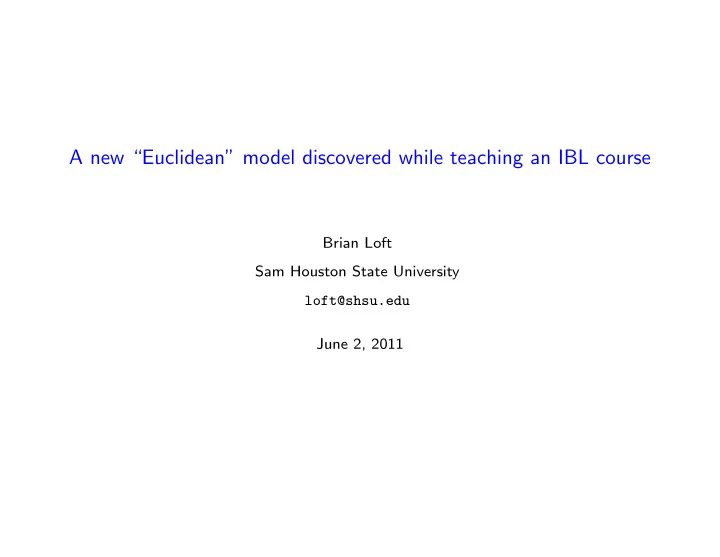

A new “Euclidean” model discovered while teaching an IBL course Brian Loft Sam Houston State University loft@shsu.edu June 2, 2011
The goals of a course in Euclidean geometry ◮ Help students improve their proof-writing techniques. ◮ Give students a better understanding of the relationship and differences between axioms and theorems. ◮ Learn some geometry – both Euclidean and non-Euclidean.
An axiomatic approach – see David Clark’s course notes ◮ Introduce some “undefined” terms point, line, plane, between, congruent ◮ Define several geometric models. – R 2 , R 3 , S 2 , the Poincar´ e Plane or Disk, discrete models ◮ Interpret the undefinable terms on these models. – What are points in R 2 ?... lines on S 2 ? ... distance? ◮ Present some axioms. – Two points determine a line. – Any line separates the set of points into two “components”. ◮ Verify the axioms on these models. ◮ Prove a list of theorems using only these axioms (or other theorems)
Hilbert’s Axioms (as written by D. Clark) The Incidence Axioms I-1 Two points determine a unique line. I-2 Every line contains at least two distinct points. I-3 There exist three distinct non-collinear points.
Hilbert’s Axioms (as written by D. Clark) The Betweenness Axioms B-1 If B is between A and C , then B is between C and A . B-2 If A , B and C are three distinct collinear points, then exactly one of them is between the other two. B-3 There are infinitely many points on any line. � � � B-4 If A ℓ B and B ℓ C , then A , C ℓ . � � � � � � B-5 If A , B ℓ and B , C ℓ , then A , C ℓ . � � �
Hilbert’s Axioms (as written by D. Clark) The Congruency Axioms C-1 Any segment may be duplicated on any given ray. C-2 Suppose that A – B – C and D – E – F . If AB ∼ = DE and BC ∼ = EF , then AC ∼ = DF . C-3 Congruence of segments is an equivalence relation. C-4 Any angle may be duplicated on any given ray. C-5 Congruence of angles is an equivalence relation. C-6 The SAS Axiom.
Parallelism Given a line ℓ and a point P not on ℓ , if there .... ◮ is a unique line m containing P parallel to ℓ , the model is Euclidean . ◮ is more than one line containing P parallel to ℓ , the model is spherical . ◮ are no lines containing P parallel to ℓ , the model is hyperbolic .
Theorems ◮ The angles opposite the congruent sides of a triangle are congruent. ◮ There is a unique line perpendicular to a given line through a given point. ◮ The sum of the angles inside a Euclidean triangle is π . ◮ The exterior angle theorem ....
There’s a Problem... The only valid Euclidean model is R 2 . The Punchline : The Problem : Most students have already assumed this!! A Solution : Present models that satisfy most of the presented axioms.... The longer these models stay valid, the less likely students are to assume that lines can only look like those in R 2 . Fewer instances of hearing “as you can see in the picture....” “it’s true because we learned it in high school....”
The Model VP Points : the points of R 2 Lines : either graphs of y = x 2 + bx + c , or vertical lines x = d . Betweenness : obvious
The Model VP Points : the points of R 2 Lines : either graphs of y = x 2 + bx + c , or vertical lines x = d . Betweenness : obvious
The Model VP Points : the points of R 2 Lines : either graphs of y = x 2 + bx + c , or vertical lines x = d . Betweenness : obvious
The Model VP Points : the points of R 2 Lines : either graphs of y = x 2 + bx + c , or vertical lines x = d . Betweenness : obvious
The Model VP Points : the points of R 2 Lines : either graphs of y = x 2 + bx + c , or vertical lines x = d . Betweenness : obvious
The Model VP At first glance, all axioms are satisfied. It’s Euclidean. But it’s not Euclidean.... Students are forced to conclude that one of the axioms fail to be satisfied! But which one?
The counterexample to SAS. B Φ Q A Φ P Φ Φ R C √ 2 + 1 5 √ φ = 4 ln(2 + 5) ≈ 1 . 47894
Use in the classroom If this (or another) counterexample is not shared with students, when will they suspect all axioms aren’t satisfied? Isosceles triangle theorem. Uniqueness of perpendicular lines. This model helps students understand the axiom/theorem dynamic, and provides a nice review of some concepts from calculus. An undergraduate research project: y = ( x − h ) n + k What about using higher-degree polynomials
Thank you for listening.... Brian Loft Sam Houston State University loft@shsu.edu
Recommend
More recommend